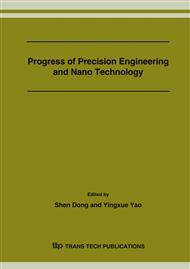p.78
p.84
p.90
p.95
p.100
p.106
p.114
p.119
p.126
Finite Element Method Predicts the Distribution of Cutting Temperature in Diamond Turning
Abstract:
In this paper, a coupled thermo-mechanical FE model is proposed to simulate the cutting temperature’s distribution produced in diamond turning. Simulated results indicate that the heat converting from plastic work has prominent effects on the distribution shape of cutting temperature field, and with an increment in cutting velocity, the locating site of maximal cutting temperature shifts from the contact area between tool tip and chip root to the contact area between rake face and chip. Cutting edge radius has minute influence on the distribution shape of cutting temperature field, but the bigger the cutting edge radius is, the higher the maximum cutting temperature in cutting region. Rake angle also has slight effects on the maximal temperature when it is more than 10○. While clearance angle reaches to 6○, the maximum cutting temperature approaches the smallest.
Info:
Periodical:
Pages:
100-105
Citation:
Online since:
May 2007
Authors:
Price:
Сopyright:
© 2007 Trans Tech Publications Ltd. All Rights Reserved
Share:
Citation:


